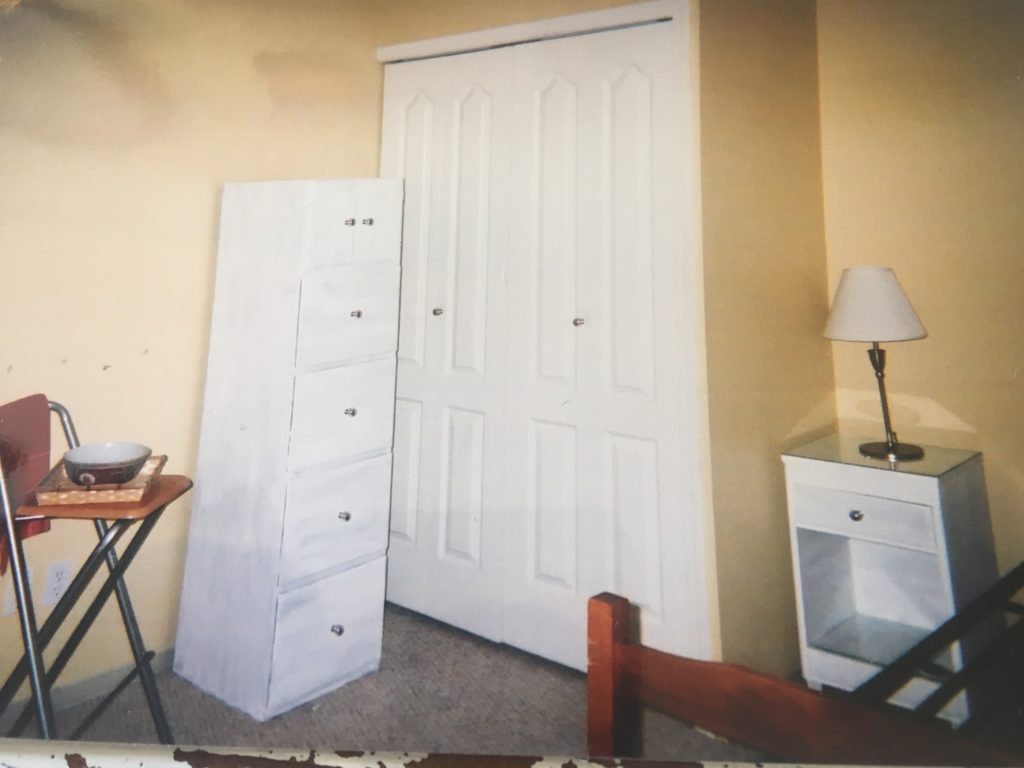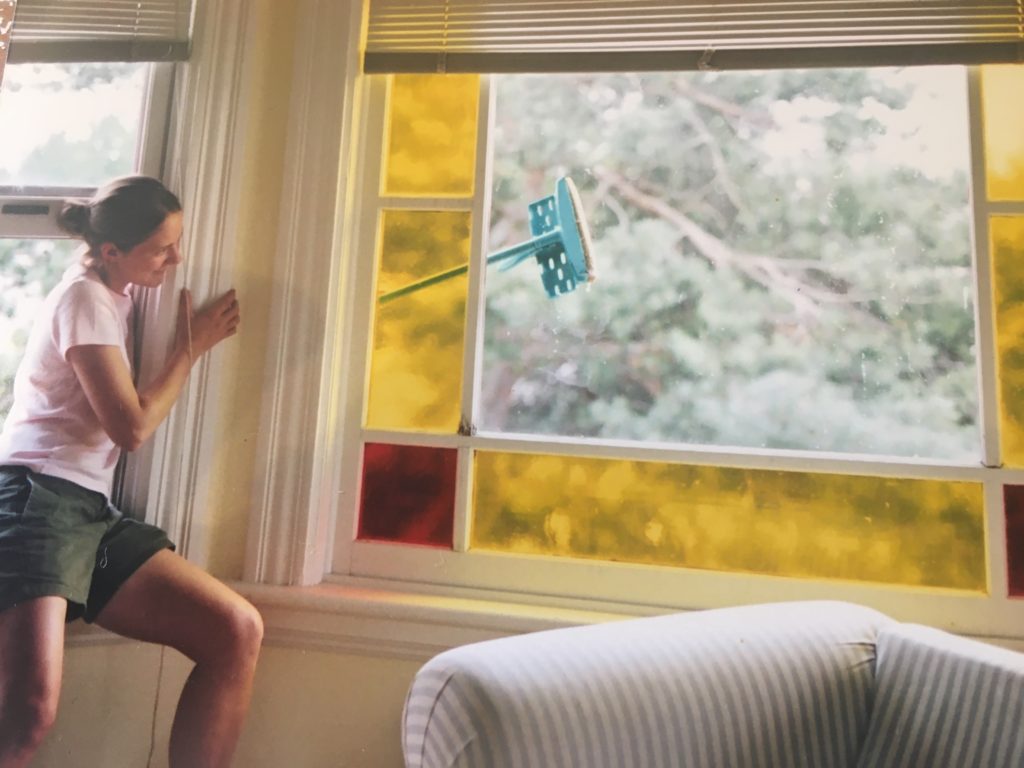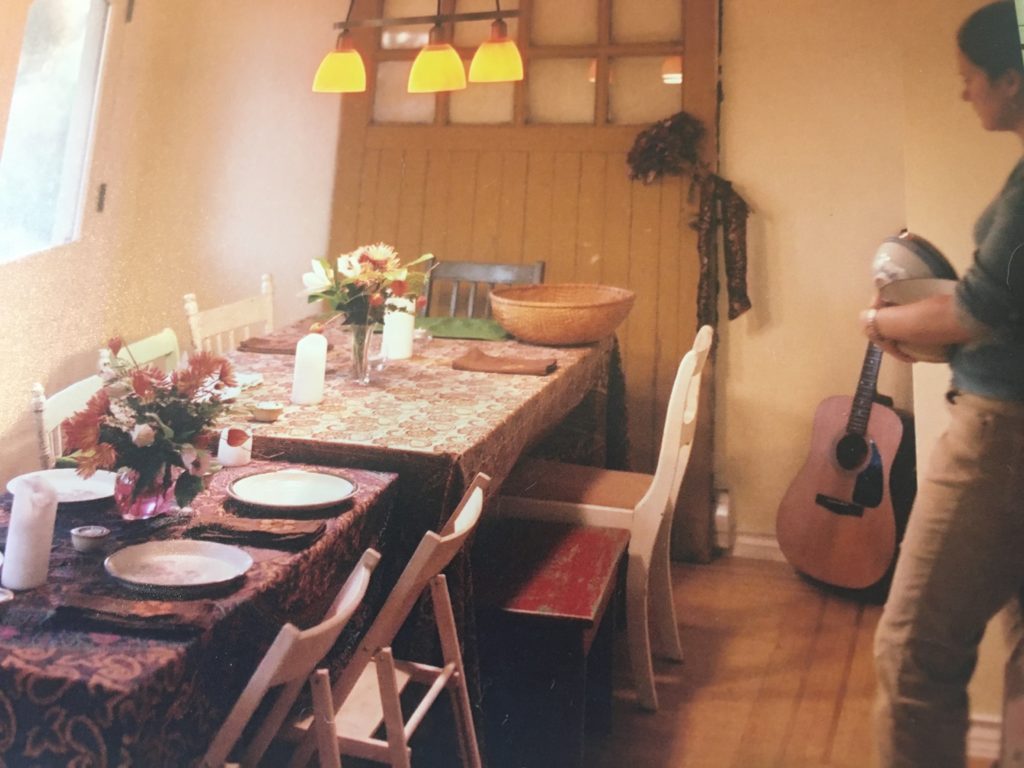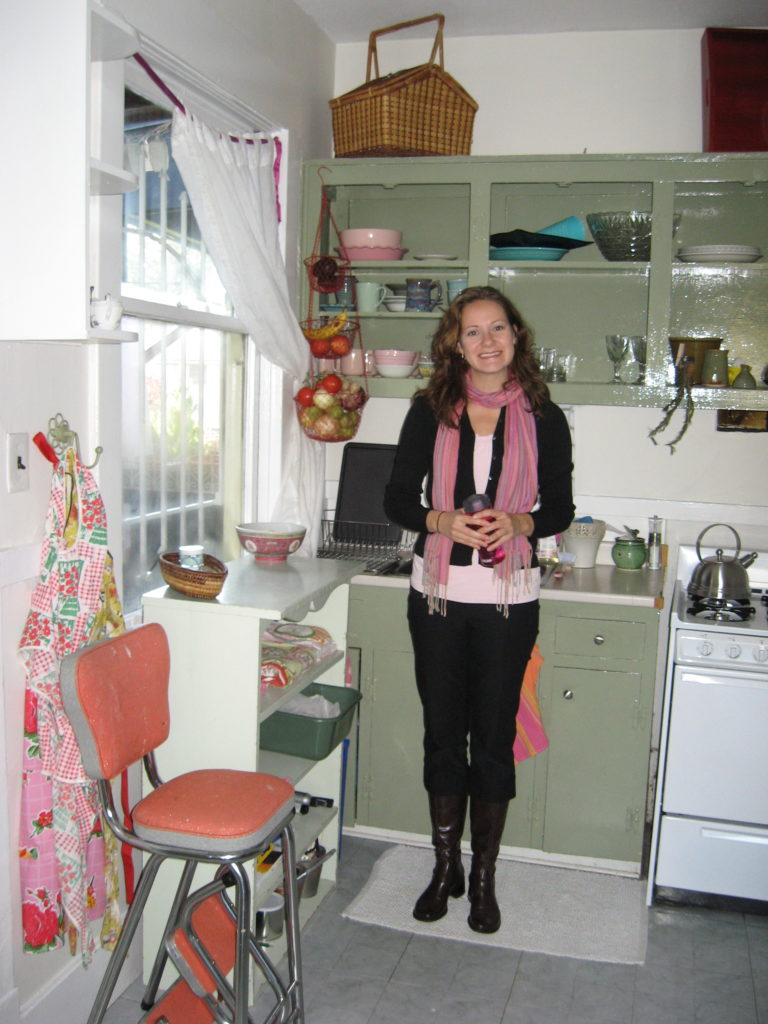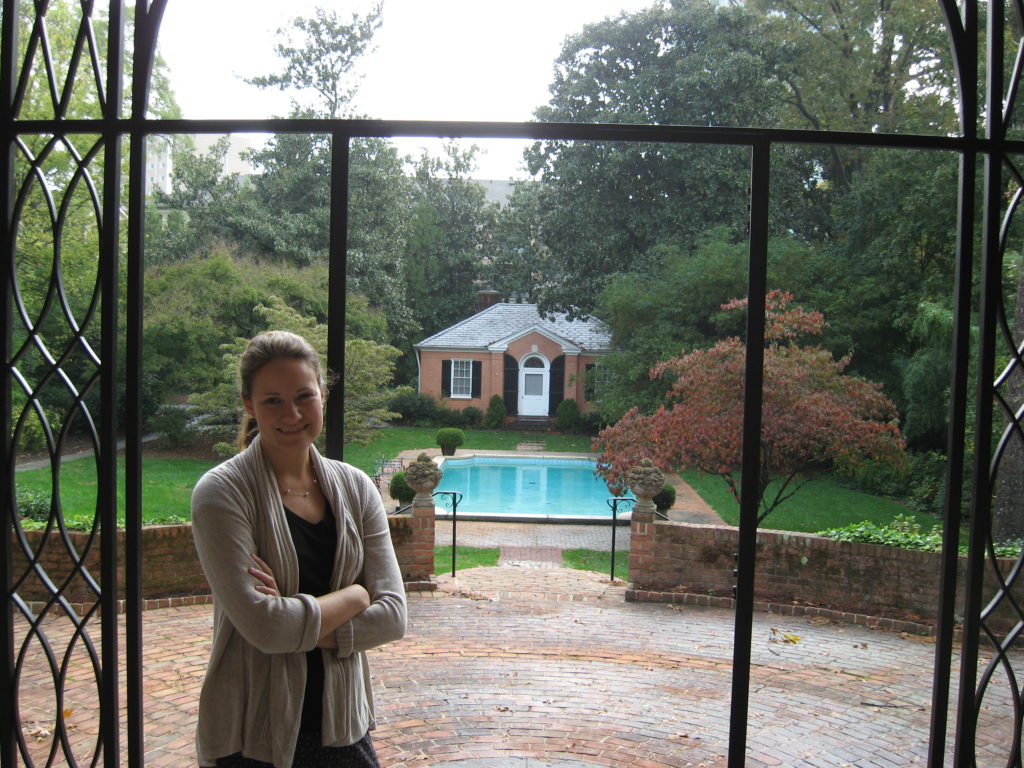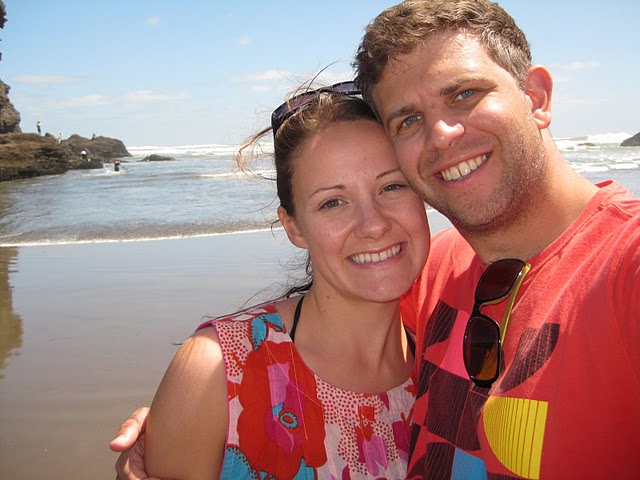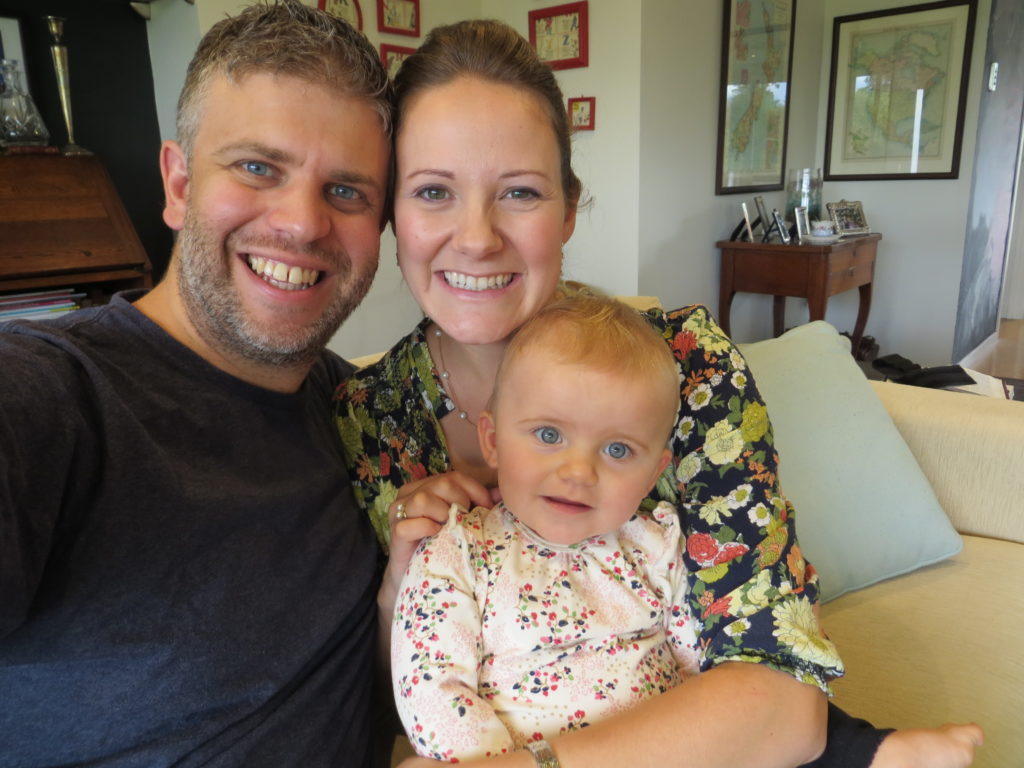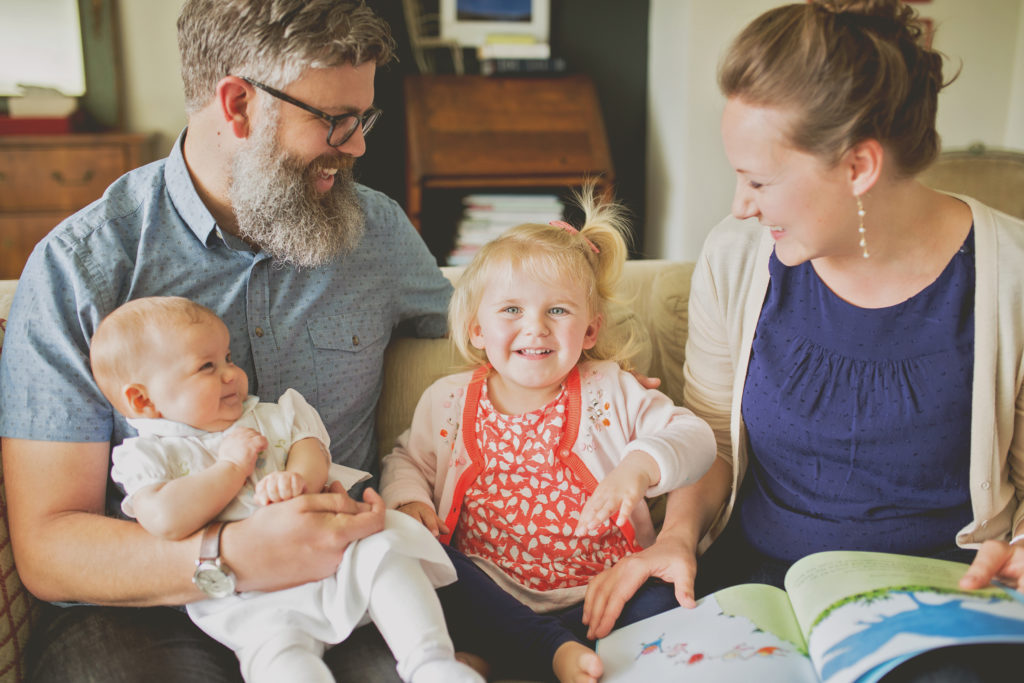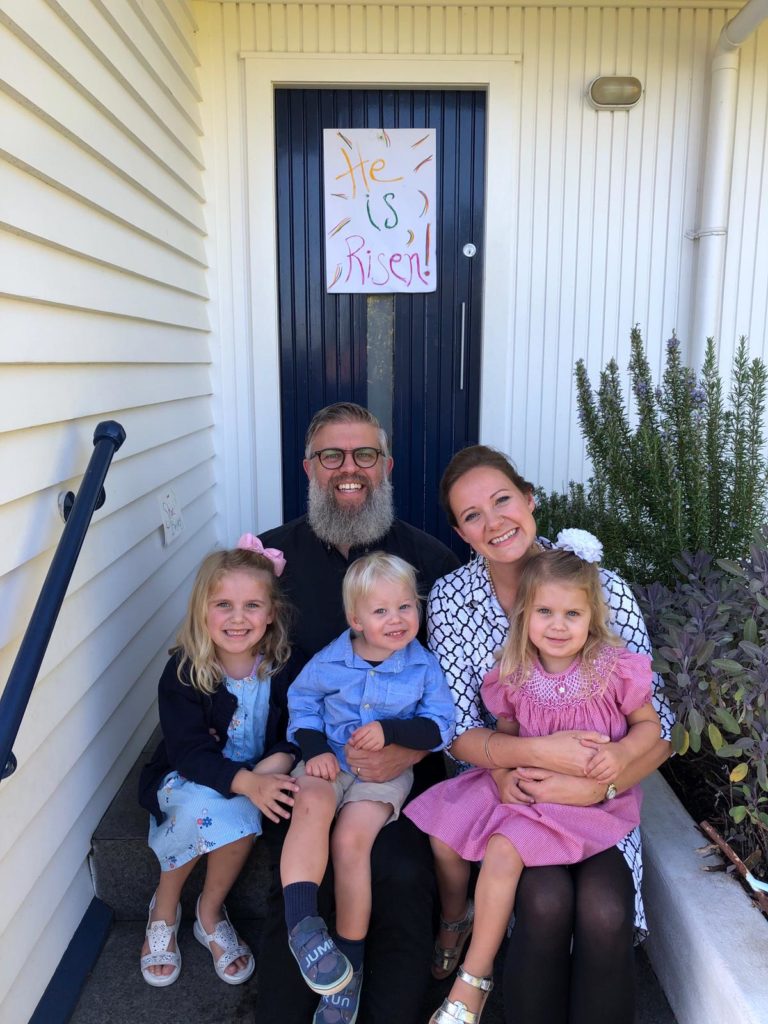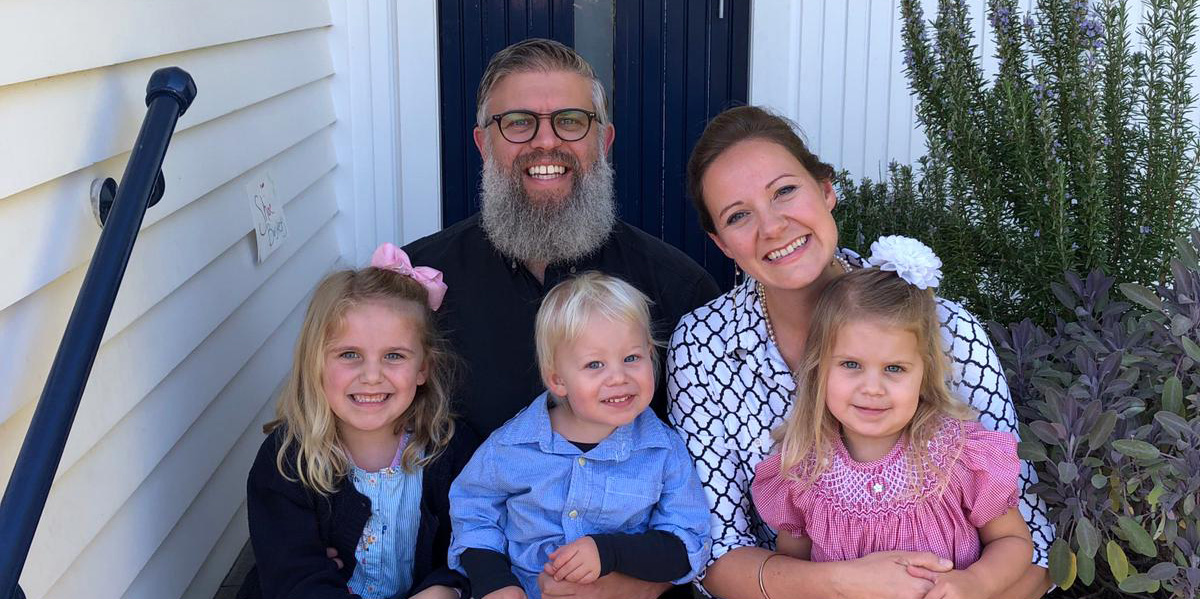
18 Nov Field Notes: Rachel Kitchens
Rachel Kitchens is on staff at Venn Foundation, offering Spiritual Direction on the Residential Fellowship, and teaching on Summer Conference. She grew up in Atlanta, Georgia and spent much of her young adult life in North America, before meeting her husband Andrew Shamy and moving to his homeland of Aotearoa, New Zealand. They live in Māngere Bridge with their three children. Here, Rachel shares some of her experience of home, homemaking, and allowing God to make a home in her life.
Let’s start at the beginning. You didn’t have a traditional upbringing—can you describe your home life for us?
Yeah, sure. The first six years of my life were spent in a very small, rural town called Fairfield, Texas. I was an only child. Those early years are always a bit hazy for anyone to recall, but what I do remember is that it was a very emotionally intense time for a child. My dad was mentally unwell, probably with an undiagnosed mental disorder of some kind. He had multiple unhealthy addictions and he was probably a rage-aholic. He was also wrapped up in some intense, cult-like, small-town-Texas groups.
We lived in a tiny apartment, in a housing subdivision off the freeway. It was dire. My dad didn’t have any money, and so our lives were quite impoverished. But I remember there were these moments of real grace during that time. Blackberries would grow every Summer along the fence of the apartment and my mum would pick all the blackberries and make this amazing cobbler every year.
My parents divorced when I was six. Overnight, my mum and I moved. It was unhealthy for us to stay there [in the home] and so we left in the middle of the night, while my dad was away, and got out of that situation. Which was scary. We spent some time with friends and then we journeyed all the way up to Atlanta, Georgia, which is where my grandparents lived.
I’d say that those early six years and leaving Texas left a very strong mark on my childhood brain. It was scary and traumatic and there was a lot of counselling I had to do after. But we landed in Atlanta, and we moved back in with my mum’s parents in a little upstairs apartment in their very large, very colonial, red brick house with a huge garden and a huge backyard.

This is me, age 8, in front of my grandparents’ home in Atlanta, Georgia 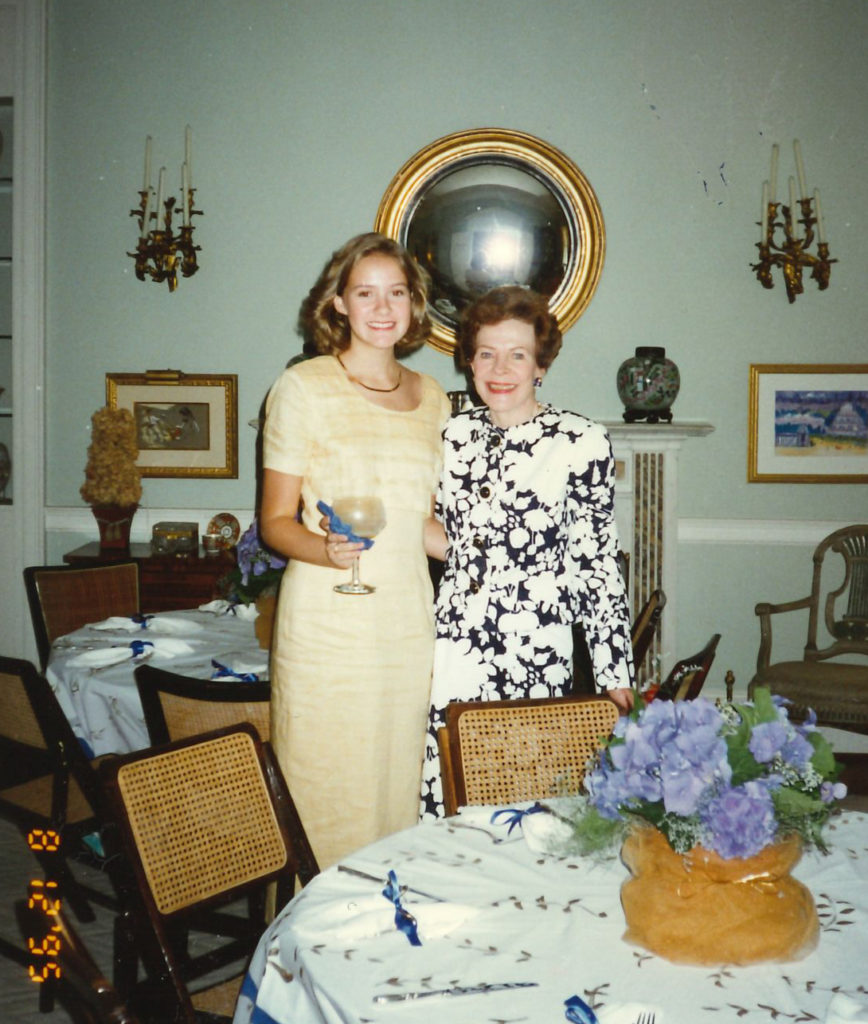
My grandmother and I when I was 18. On a whim, I planned a special lunch with my grandmother for some close friends for our shared birthdays.
As a child, that home became a place of deep healing for me. It created this steady, peaceful, beautiful, artistic, creative, home of warm hospitality. It was this place where deep healing and imagination and love and care just blossomed, all at once. That house deeply marked me as a child. There were three generations living in the same house, which was quite unusual at that time. The way in which my grandparents welcomed us in was profound and significant.
My grandparents were quite hospitable people. They loved to throw parties, to welcome people in. There was this annual Christmas party that we had the day after Christmas. There were easily 250-300 people in and out of the house for that night. It was just magical. It was winter, so everyone in Atlanta wanted to wear their fur coats—which they didn’t need, because Atlanta is quite warm. The fur coats would be laid out on my grandparents’ bed and I remember running into their room and just jumping onto the coats. It was this puff of fur—it was so much fun.
Looking back onto those early years—moving from an intense and troubled home life to a beautiful, established home with your grandparents—how did you find the transition?
It felt like shock. I was an extremely shy child, very introverted and very sensitive. The juxtaposition was so intense that I was just in shock for a long time. I remember just looking at things around me and not taking them in. I would sit for a long time and look at the birds, look at the garden. It was this strange invitation to just ‘be’ as a child, and that was powerful. I think there were things that were happening emotionally and spiritually, but I could not name them. And I could not understand what was happening.
Only in my older years could I go back and see what was happening. I could see what a gift it was, what a gift my grandparents were. My mum left the whole family to get married. She became a Christian in the Jesus movement in the 70s and 80s. Hers was a full transformation: move on to a completely different life, move state, move community, stop eating certain foods, stop drinking, stop partying, stop smoking—just everything. She went real extreme.
She’d left my grandparents and they didn’t really have any contact, but then, years later, we show up at their doorstep. My mum was like, “I have nowhere else to go,” and my grandparents said, “Well, you can stay with us.” They hadn’t seen or heard from their daughter in years, but they were so completely arms open to us. When she came back, there were lots of conversations that needed to happen. But there was no judgment, no criticism, they were just so happy to have us with them. My relationship with my grandparents was very, very strong because of that.
Growing up in my grandparents’ home informed the future of hospitality and home for me. It was quite hot in Atlanta—very, very humid in summer—and these fireflies would come out at dusk. I’d capture them in a jar and sleep with the glowing fireflies next to my bed every night in the summertime. It was magical.
I was ten when my grandfather died, which was its own grief. At that point, my mum and I moved into our own little house, an apartment. But for me, my spiritual and emotional home was still my grandparents’ home. Even to this day, I still dream very intensely about that house.
Tell us about some of the other homes you’ve lived in—what have been some of their markers and what have you learned about making a home?
I finished high school in Atlanta, then went to Hollins University in Virginia to study Dance and Psychology. That started a quick succession of moving cities and homes. I lived in Virginia for university, then Washington DC for work. One of my homes was a huge walk-up [apartment] in downtown DC, an area full of crack-houses and lots of gun violence—but it was really cheap rent. I was an artist at the time and I had other friends that were barely making it. We did all this crazy stuff to the house. It was really fun. Then I lived in a really mouldy basement. It was just that season of your twenties and thirties where you’re flatting and just trying to make ends meet.
I call my twenties the “ploughing of the earth” years. I was constantly ploughing up stuff, figuring out what the soil of my life is, figuring out who I’m going to be, what I’m excited about, what I’m not excited about, who I want around me. In my homes during that season, I always wanted to live in community, and I always wanted to have beauty around me—to have that sense of peace and calm. When you feel like you’re coming to a place of home, in the true sense of the word, you can really be who you are. I needed that for myself and for the people I wanted to live with.
Home has always been a place for me to resettle, to find peace, and to really go deep with God and myself. Beauty is really important to me to make these spaces work and I would always want to invite people over and be hospitable to them. At the time, I had a lot of questions of home and life and art and faith and God.
Then I went to Regent College in Vancouver, which was a really powerful experience. One of my houses in Vancouver was this tiny little place we called the “mouse house.” It was three metres by three metres. You’d walk in the front door and there was a bed, a teeny-tiny kitchen, a bathroom, and a tiny closet. And that was it. It was just like a mouse house. But everything that was given to me in that house was just perfect. That was another place for me to heal, so it was good to live on my own for a time.
While I was at Regent, I also lived in an intentional community in the middle of the city. We lived in an old brownstone—a beautiful house—among people that were socio-economically struggling. There was a lot of mental illness and drug addiction. We tried to do life alongside people who were living in that city, tried to offer them respite and hope. We lived in the neighbourhood, we grew a garden next door to our house, we chatted with people, and we’d offer hospitality out of that space. I was doing theological work at that time, and I wanted to work out what it means to walk alongside those who are struggling. We got broken into and things got stolen, but it was a place where I realised what it actually means to be in intentional community with people who have a lot less than you. We were trying to be incarnational in the middle of the city.
You met Andrew at Regent and then moved to Aotearoa, New Zealand shortly after. How did your understanding of home shift as you moved country?
There was a deep dislocation, disorientation, and breakdown when we moved to New Zealand. I moved because I loved Andrew. When we were dating, Andrew told me he felt called to New Zealand and that’s where he intended to return to. I didn’t feel called to America, and so I said, “Okay, I’m in.” I understood what Andrew was saying, what it would mean.
But it was still a great shock. The first year was like orientation year: I was newly married, and I had a new home and everything was new. Then about a year after we arrived, I went through this deep, dark depression. I had gone back to see my family and we had celebrated thanksgiving, then I returned to New Zealand, and I think that was the trigger point. I thought, “I’ve got to figure out how to make home in this totally new place.” Culturally it is so different, and I didn’t know what’s normal here. It was exacerbated because during that same time my grandmother had died, and my mum was selling my grandparents’ house: where I grew up. At the same time, Andrew and I couldn’t buy our own home because the market was so hard. We were renting, but I wanted to buy a home and paint the walls. My spiritual, emotional home was being sold and I didn’t have a home to rest in here, so I was in this in-between space.
I became fixated on finding a home, because I really wanted to feel grounded and peaceful. My childhood home had been shaken: the new owners had moved in and painted the place, and everything was different. But the thing that I wanted—a home of my own—was not the thing that was going to solve the problem. God did some work on me. We couldn’t find a place to buy and so I was stripped of this idealism that the home was what I needed to be ok, to be alright. It had become an idol.
When we did finally buy, it was with an open hand rather than a clenched fist. I could finally trust God to provide, instead of telling God: “This is what I need in order to feel good—and you need to give it to me.”
Home had become really, really wrapped up in my identity and it was no longer a healthy space for me to be in. That’s why Andrew bought our house without me seeing it before-hand. He bought it on my birthday, the day I turned thirty-five. The next day I found out we were pregnant. So, I had a little home for myself, on my birthday, and a little baby growing in my womb, which was its own home. It was this little, beautiful gift from God. But it needed to be cleansed, my sense of what home is and what it was creating for me.
How did you handle the gap between the longing for a home and its realisation?
Well, I got really sad. Every day I had to communicate to God how I was feeling. I got really angry during that grief process, but I didn’t shut God out even though some days I wanted to. I would go for very long walks, where I would just pray and cry, or rant. I had to surrender, every day. There were some moments—making a cup of tea or sitting in the lounge—I’d feel such sadness and I would turn that into a prayer. I’d just say, “I’m surrendering this moment.” I didn’t know what each moment was; it was kind of similar to the shock I experienced as a child when we arrived at my grandparents. I’d just sit in silence. Sometimes God would speak. And sometimes he wouldn’t.
It’s like God was there with me, like a friend would be. It was this hiddenness, hidden even to me. I didn’t know what was going on. Some days were better than others, some days I’d have a glimpse of what was happening. And then some days I wouldn’t.
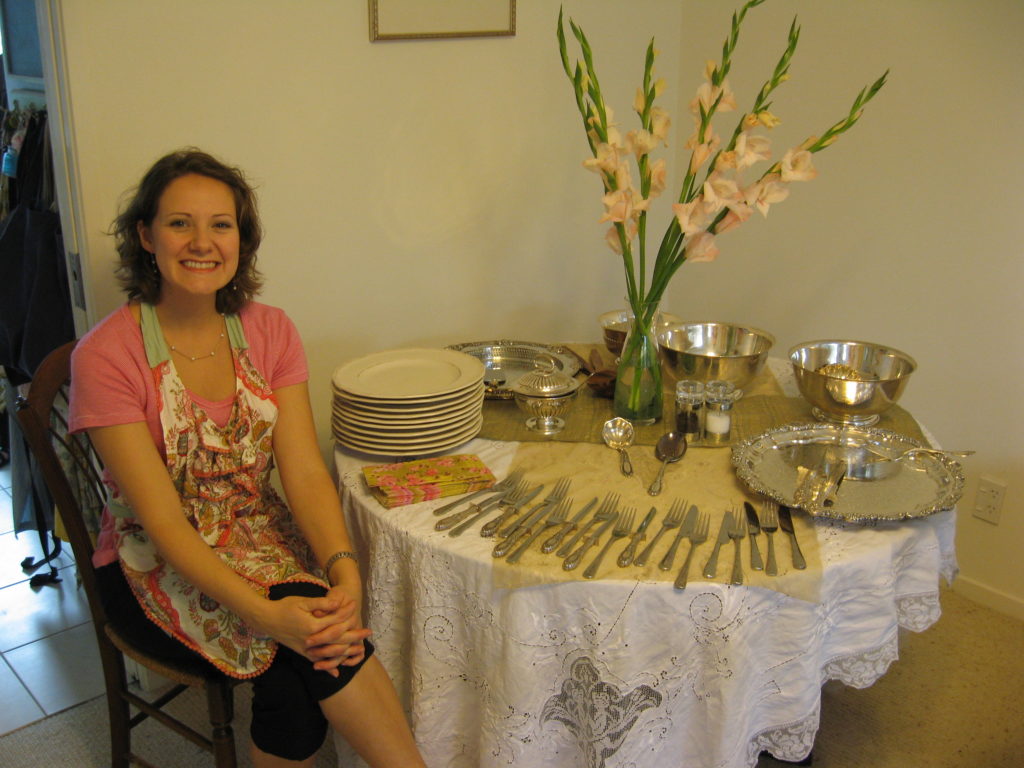
All of my grandmother’s silver had finally arrived from the container ship across the ocean, just in time for Easter celebrations in Auckland, 2011.
There were a few moments of grace. KitchenAid mixers are really expensive in New Zealand, like a thousand dollars, and I really wanted one but didn’t want to spend that money on a mixer. One day I was going to work—Andrew was dropping me off—and we passed a church boot sale. This guy was getting out of his car and picking up a red KitchenAid mixer, which is the colour in my kitchen, and dropping it off at the church. Andrew ran to the guy and said, “Excuse me, how much do you want for that?” And the guy just said “a hundred dollars,” so we got it for a hundred!
Slowly beauty came back. Slowly, I remembered the things I love doing. Slowly I was able to come into a new place. I had felt so sick for so long that I thought nothing could take place in me that was life-giving, so when we found out I was pregnant, I realised there is life that God wants to put in me, even though I didn’t feel ready, willing, or able. That was a deep surprise and mystery.
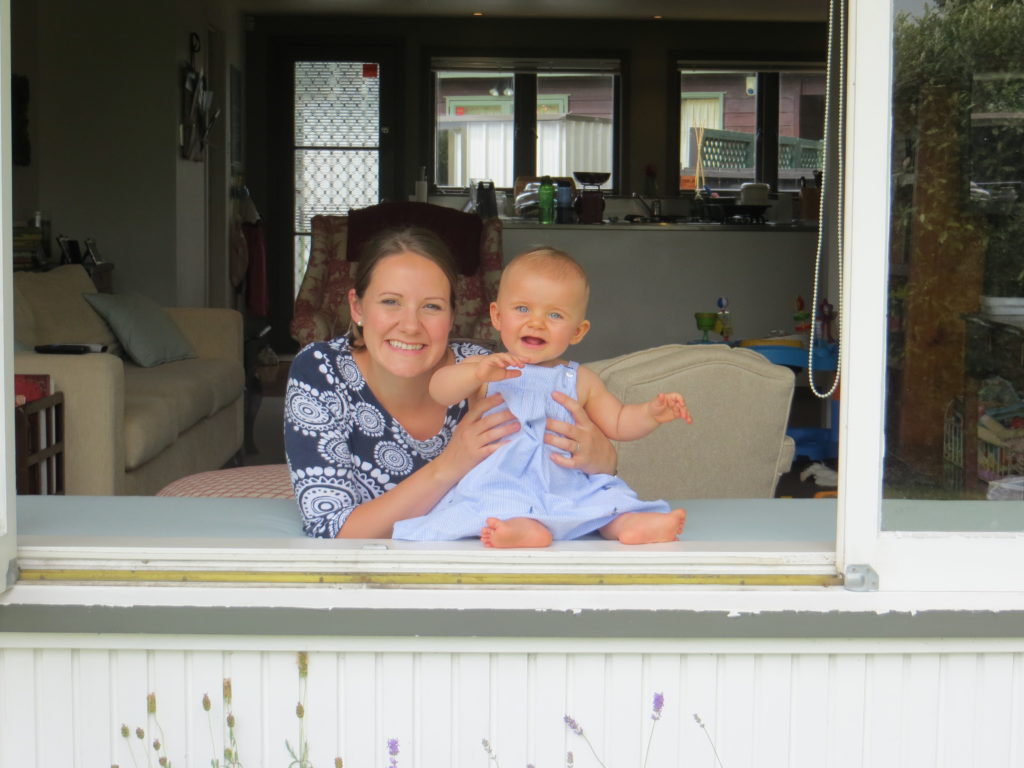
In our first bought home, with our new baby, 2013. 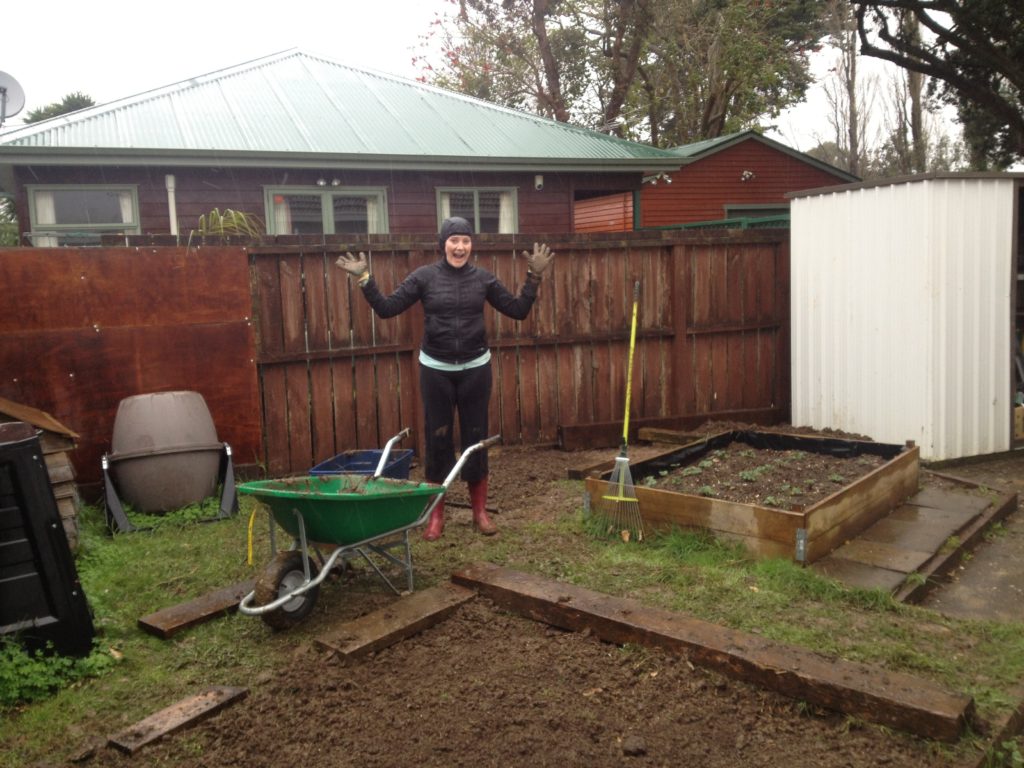
A total re-do of our garden at our current house, 2013. Our first child, Ella, is six months old.
I had to re-understand what home is, in regards to children and infants who don’t care about your picture-perfect home. But even in the midst of that, it was just about surrendering my ideals, my hopes, my longings. I remember feeding all my babies in the middle of the night and thinking, God is close to the broken-hearted. My spirit wasn’t broken, but my body felt broken. I needed to just ask, “God would you be here with me right now?” Again, it was surrendering to the stillness and the silence of the moment. That has been the strange gift of being depressed and being really unwell. There’s this total stripping back of the masks and the ways in which I might make things perfect. And God is still present to me—he doesn’t care if I’m cleaned up or not. He just wants to be with me, wherever I’m at, and invites me to be with him.
That’s one of the main themes of Advent: God’s people preparing their hearts and lives for God Immanuel to come and make his home among us. Can you speak more to that?
Yes, Advent is this amazing season we can enter into. It’s a season of surrender. We let go of all the baggage that we’ve carried with us during the year. It’s like Lent, which has the same liturgical colour (purple) and a similar feel. It’s a stripping away of attachments so that we can make space in our lives for the Christ child, God Immanuel.
We enter this time of Advent and do a little stocktake: like you would if you were purging your garage or cleaning your closet. We take stock and we ask, “What things have I allowed into my life this year that I have made attachments to, or idols out of, that I need to surrender?” And “How do I make space to allow Jesus to come into my life afresh and anew?” We need to do that every year, because we forget. Advent is a season where we invite God to give us the eyes to see the clutter and to give us the ability to put it away. That clutter, or those idols, can be anything. It can be the way we are with our kids, how we feel about our colleagues at work, our ways of thinking. We make space and we ask God what we should pay attention to. What kind of home does God want us to make in our hearts and minds and spirits and bodies, so that Jesus can come in?
I love Advent. It’s really about putting aside time. Now, I know this is difficult. As a parent, I need to shop for food and buy presents and make preparations for Christmas Day and have family time and see people. All those things. But really, Advent is an invitation to step into de-cluttering and letting go of attachments that we’ve let form, and making space in our lives for Jesus. That’s why Advent is so powerful if we can enter into it fully. And then the joy of Christmas is so rich because we’ve made space, we’ve made a home for Jesus to be with us.
To finish our conversation, can you tell us some of the ways you and your family shape your home during Advent?
We do a lot of practical things. James, our youngest, has his birthday on the twenty-ninth of November, which is around the first Sunday of Advent. On that first Sunday, we get out our Christmas things to decorate the house after church. That’s the Christmas tree, wreath, and all the decorations. We set up an Advent candle arrangement and each of the kids have their own wooden nativity that they can play with. We also have an Advent wreath. Last year I made it from succulents and I’ve been able to keep it alive, so it’s hanging up already. We’ll continue to nurture that and hopefully it’ll continue to grow.
We usually do a reading on the first Sunday of Advent and then we light the candle for each week. We also have an Advent calendar that has little pockets filled with a Scripture and a lolly for the kids on each of the days. Every night before bed, the kids get into their pyjamas, we light the candle, we read a piece of Scripture, we give them a lolly, we briefly tell them the story, and we ask them some questions. The kids really, really look forward to that.
We make sure to attend our little church, St James, whenever we can, which is really important. And then my mum usually comes from the States to stay with us. She won’t be doing that this year, obviously, but that’s a really important time for me to connect with her. I’m an only child and I’m also an only grandchild, so I have no first cousins. My mum is very connected to us. Andrew’s family always goes away every second year to a beach bach, which we’ll be doing this year.
One thing we try not to do is get caught up in the consumerism of Christmas. We try not to fall into busyness, or do too much shopping. We make sure to make space in the evenings to read, write, do some art practice, pray. We don’t fill our evenings in Advent. I think the Christian church can get caught up in the busyness as well: feeling a need to do all the things. We try to find some Advent-ish music to play during the season, and Andrew and I do a check-in with each other at the end of the year. We ask, “How was the year, where did God show up, what did you notice?” We try to do that before the Christmas season is over.
We’ve explored Advent elsewhere in Common Ground, including an article by Rachel Kitchens describing how to make an Advent wreath, along with other meditations on the season.
(Images: Supplied by Rachel Kitchens, 2021)


